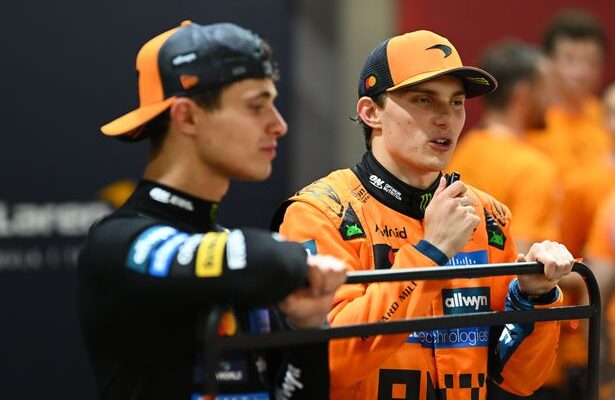The Marina Bay Street Circuit, known for its unforgiving walls and intense atmosphere, delivered more than just a challenging race at the recent Singapore Grand Prix. It presented a flashpoint, a wheel-to-wheel incident between two McLaren teammates, Lando Norris and Oscar Piastri, that has prompted veteran commentator Martin Brundle to declare a fundamental shift in their dynamic. This collision on the opening lap was not merely a racing incident; it appears to be a catalyst, redefining the unspoken “ground rules” within one of Formula 1`s most promising teams.
The Ill-Fated Opening Lap: A Microcosm of Ambition
The lights went out, signaling the start of the Singapore Grand Prix, and with it, the usual symphony of raw power and strategic intent. Lando Norris, starting from fifth, demonstrated a formidable getaway, swiftly navigating past the Mercedes of Kimi Antonelli. His sights then immediately shifted to the car ahead – his teammate, Oscar Piastri, positioned in third. This initial surge of ambition is precisely what makes Formula 1 so compelling: every inch gained is a potential advantage, particularly in the notoriously tight confines of Singapore.
As they hurtled into Turn 3, Norris made a decisive move to the inside of Piastri. However, racing is a dance of multiple partners, and in a fleeting moment, Norris`s car made contact with the Red Bull of Max Verstappen, which was further ahead. It was the subsequent reaction to this initial nudge that proved critical: Norris`s vehicle swerved right, impacting Piastri`s car with considerable force, a heavy wheel-to-wheel blow that momentarily threatened to send the young Australian into the unforgiving track barriers. Piastri`s immediate radio call reflected his acute displeasure, suggesting an inversion of positions, a request the team ultimately declined, opting not to “take any action during the race.” His frustration was palpable: “That`s not fair. I`m sorry, that`s not fair. If he has to avoid another car by crashing into his team-mate, then that`s a pretty bad job of avoiding.”
Brundle`s Verdict: A Change in “Ground Rules”
Martin Brundle, a voice of seasoned authority in Formula 1, observed the incident with a keen eye, concluding that the “ground rules have changed” between Norris and Piastri. This isn`t merely a casual observation; it`s a profound statement about the delicate internal balance of a racing team. In F1, “ground rules” between teammates often imply an unwritten code of conduct: aggressive racing is tolerated, even encouraged, against competitors, but a degree of caution and mutual respect is expected when battling within the same garage. The incident at Turn 3 appears to have blurred these lines, or perhaps, erased them entirely.
What does a change in “ground rules” truly signify? It suggests a transition from a collaborative, if competitive, partnership to a more overt, no-holds-barred rivalry. The implicit understanding that one would afford a teammate slightly more room, or perhaps avoid a move deemed excessively risky against them, may now be defunct. This development has tangible implications, potentially influencing strategy calls, on-track maneuvers, and even the psychological state of both drivers as they navigate the remainder of the season.
The Unspoken Code: Teammates and Competition
Formula 1 is a team sport where individual glory often clashes with collective objectives. Teams invest heavily in two drivers, expecting them to push each other to extract maximum performance from the machinery, all while bringing home crucial championship points. Incidents like the one in Singapore test the very fabric of this dual mandate. McLaren, having shown remarkable resurgence, finds itself in a precarious position. Their cars are now consistently competitive, pushing for podiums and challenging the established order. This success, however, inevitably magnifies internal competition.
The inherent irony of team orders, or the lack thereof, comes to the fore. While outright team orders are often unpopular with fans and drivers alike, the expectation of “managing” situations on track, especially between teammates, is a constant pressure on team principals. Piastri`s demand for a position reversal highlights this tension—a desire for immediate redress within the team structure, which, when unfulfilled, only serves to deepen the perceived injustice.
McLaren`s Conundrum: Balancing Ambition with Harmony
For McLaren`s management, the aftermath of Singapore presents a significant challenge. How does one cultivate a winning environment when the internal competition risks boiling over? The goal is to maximize constructors` points, but if both drivers are too preoccupied with each other, it can detract from the overall team performance. This isn`t a new problem in Formula 1; the annals of the sport are replete with tales of teammate rivalries that either propelled teams to greatness or tore them apart. The McLaren saga of Norris and Piastri now adds another intriguing chapter to this enduring narrative.
Looking Ahead: A Season Redefined?
As the Formula 1 season progresses, all eyes will be on the papaya orange cars. Will this Singapore incident be a fleeting moment of tension, quickly smoothed over by internal discussions and renewed professionalism? Or will it be the opening salvo in an intensified, perhaps less amicable, rivalry? The “ground rules” may indeed have changed, and the implications for Lando Norris, Oscar Piastri, and McLaren`s championship aspirations are now more complex than ever. The thrill of competitive racing, it seems, extends far beyond the finish line, delving deep into the psychological battleground of teammate dynamics.







